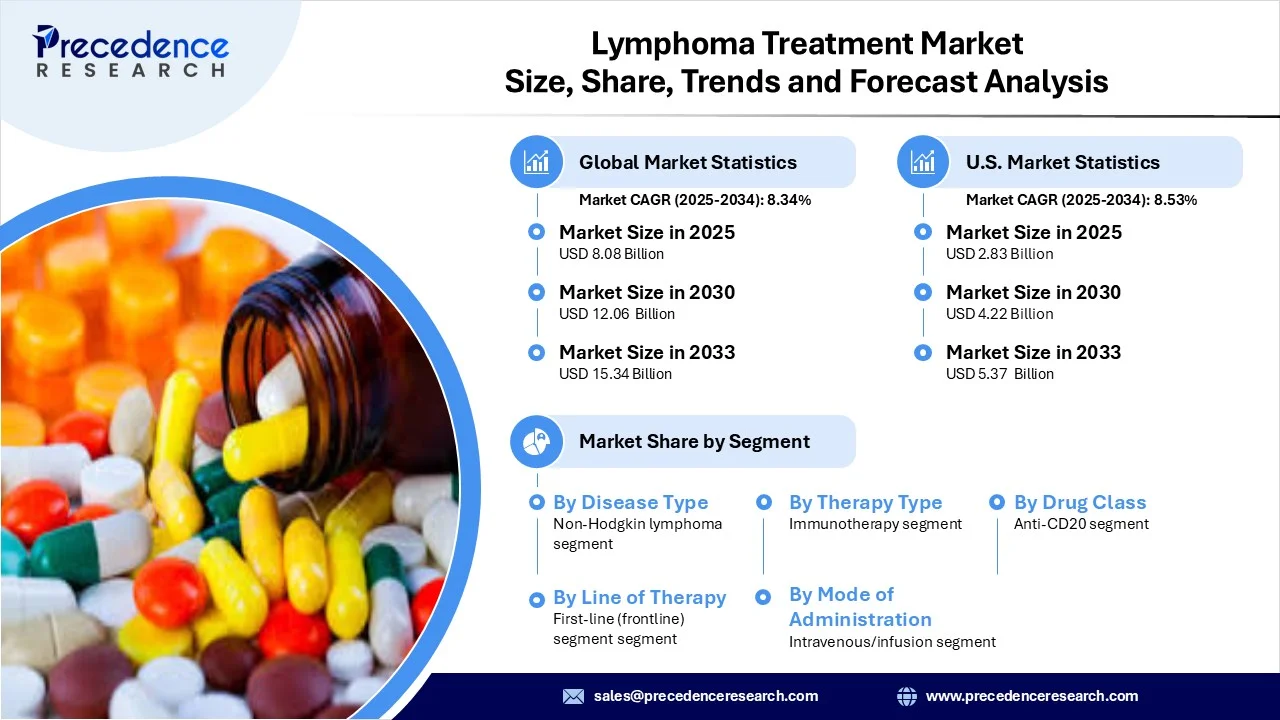Lymphoma Treatment Market Revenue to Attain USD 15.34 Bn by 2033
Lymphoma Treatment Market Revenue and Trends 2025 to 2033
The global lymphoma treatment market revenue reached USD 8.08 billion in 2025 and is predicted to attain around USD 15.34 billion by 2033 with a CAGR of 8.34%. The lymphoma treatment market is rising due to increasing incidence of lymphoma globally, accelerated approvals of novel immunotherapies and targeted drugs, and growing healthcare spending coupled with better diagnostic infrastructure.

Key drivers influencing the growth of the lymphoma treatment market
Several important factors are driving growth in the lymphoma treatment market. New immunotherapy and targeted methods, including CAR-T cell therapies, bispecific antibodies, and newer monoclonal antibodies, are showing high efficacy and fewer side effects over traditional chemotherapy as they gain higher levels of consumption now. Many research and healthcare settings are increasing awareness and utilization of earlier detection supported by advanced imaging, molecular diagnostics and screening which is creating more market participants that can be treated and/or take up novel therapies.
The increased efficacy of new therapies, quicker regulatory processes in many jurisdictions with improved support for research and funding for earlier stage novel therapies in unlicensed indications, such as relapsed/refractory disease, all allow for simpler and quicker timelines to patients for therapy to reach the market.
Segment Insights
- By disease type, the non-Hodgkin lymphoma (NHL) has the largest segment due to being a more common disease globally, consisting of different sub-types, and necessitating more avenues for treatment when compared to Hodgkin lymphoma.
- By therapy type, immunotherapy / targeted therapies is the largest segment based on response rates within the market, ability to use in earlier lines of therapy, and all of the newer approved therapies including CAR-T, bispecifics, and small molecule inhibitors.
- By drug class, the anti-CD20 monoclonal antibodies is the dominant segment, based on their extensive use in first-line therapy and combination with chemotherapy for B-cell lymphomas, ongoing clinical research and biosimilars coming to market.
- By line of therapy, the first-line therapy has the largest segment due to the largest number of approved therapies, the largest number of clinical trials, the most focus on patient outcomes outlined in treatment pathways and guidelines given the greatest overall impact on the patient long-term when evaluating treatments based on patient response.
- By mode of administration, the intravenous segment has the largest market size as that is the traditional method for delivering monoclonal antibodies, chemotherapy and CAR-T which is why patients had received intravenous therapies.
Lymphoma Treatment Market Coverage
| Report Attribute | Key Statistics |
| Market Revenue in 2025 | USD 8.08 Billion |
| Market Revenue by 2033 | USD 15.34 Billion |
| CAGR from 2025 to 2033 | 8.34% |
| Quantitative Units | Revenue in USD million/billion, Volume in units |
| Largest Market | North America |
| Base Year | 2024 |
| Regions Covered | North America, Europe, Asia-Pacific, Latin America, and Middle East & Africa |
Regional Insights
North America is the highest revenue generating region, with roughly 40-50% of revenues over the last few years in the global lymphoma treatment market. This is driven by the U.S. that has a robust healthcare landscape with advanced regulatory settings, high levels of overall healthcare spend across all therapies, ease of getting earlier adopters to access new therapies, and a number of global players with research and development pipelines supporting newer therapies.
The Asia-Pacific region is the fastest growing region for lymphoma treatment and the other factors that are presently driving growth for countries like China and Japan, much of this growth is being driven by at least two other factors that countries like these have large absolute patient populations with higher incidence rates for lymphoma and also improving their capacity to diagnosis and treat lymphomas through and improved healthcare infrastructure and government healthcare investments across these countries.
Lymphoma Treatment Market Key Players
- F. Hoffmann-La Roche (Roche)
- Novartis • Gilead Sciences (Kite/Gilead)
- Bristol-Myers Squibb
- Pfizer
- AstraZeneca
- Bayer
- BeiGene
- Johnson & Johnson (Janssen)
- AbbVie
- Takeda
- Amgen
- Eli Lilly
- Incyte
- Biogen
Recent Development
- In June 2025, the U.S. FDA approved tafasilamab (Monjuvi / Minjuvi) for relapsed or refractory follicular lymphoma, substantially expanding options for patients who have had prior lines of therapy. This came after the inMIND trial (NCT04680052) demonstrated meaningful overall and partial response rates when combined with lenalidomide and rituximab. (Source- https://www.fda.gov)
Get this report to explore global market size, share, CAGR, and trends, featuring detailed segmental analysis and an insightful competitive landscape overview @ https://www.precedenceresearch.com/sample/6778
You can place an order or ask any questions, please feel free to contact at sales@precedenceresearch.com |+1 804 441 9344